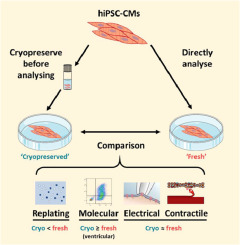Stem Cell Research ( IF 0.8 ) Pub Date : 2020-01-07 , DOI: 10.1016/j.scr.2019.101698 Lettine van den Brink 1 , Karina O Brandão 1 , Loukia Yiangou 1 , Mervyn P H Mol 1 , Catarina Grandela 1 , Christine L Mummery 1 , Arie O Verkerk 2 , Richard P Davis 1

|
Human induced pluripotent stem cell-derived cardiomyocytes (hiPSC-CMs) have emerged as a powerful platform for in vitro modelling of cardiac diseases, safety pharmacology and drug screening. All these applications require large quantities of well-characterised and standardised batches of hiPSC-CMs. Cryopreservation of hiPSC-CMs without affecting their biochemical or biophysical phenotype is essential for facilitating this, but ideally requires the cells being unchanged by the freeze-thaw procedure. We therefore compared the in vitro functional and molecular characteristics of fresh and cryopreserved hiPSC-CMs generated from multiple independent hiPSC lines. While the frozen hiPSC-CMs exhibited poorer replating than their freshly-derived counterparts, there was no difference in the proportion of cardiomyocytes retrieved from the mixed population when this was factored in, although for several lines a higher percentage of ventricular-like hiPSC-CMs were recovered following cryopreservation. Furthermore, cryopreserved hiPSC-CMs from one line exhibited longer action potential durations. These results provide evidence that cryopreservation does not compromise the in vitro molecular, physiological and mechanical properties of hiPSC-CMs, though can lead to an enrichment in ventricular myocytes. It also validates this procedure for storing hiPSC-CMs, thereby allowing the same batch of hiPSC-CMs to be used for multiple applications and evaluations.
中文翻译:

人类多能干细胞来源的心肌细胞的冷冻保存对其分子和功能特性无害。
人类诱导的多能干细胞衍生的心肌细胞(hiPSC-CM)已成为心脏疾病,安全药理学和药物筛选的体外建模的强大平台。所有这些应用都需要大量特性良好且标准化的hiPSC-CM批次。在不影响hiPSC-CM的生化或生物物理表型的条件下进行冷冻保存对于促进这一点至关重要,但是理想情况下,需要通过冻融程序使细胞保持不变。因此,我们比较了从多个独立的hiPSC系产生的新鲜和冷冻保存的hiPSC-CM的体外功能和分子特征。尽管冷冻的hiPSC-CM的电镀效果比刚衍生的同类产品差,加入混合种群后,回收的心肌细胞比例没有差异,尽管对于数个品系,冷冻保存后可回收更高百分比的心室样hiPSC-CM。此外,来自一条细胞的冷冻保存的hiPSC-CM表现出更长的动作电位持续时间。这些结果提供了证据表明,冷冻保存不会损害hiPSC-CMs的体外分子,生理和机械特性,尽管会导致心室肌细胞的富集。它还验证了用于存储hiPSC-CM的此过程,从而允许将同一批hiPSC-CM用于多个应用程序和评估。来自一条细胞的冷冻保存的hiPSC-CM表现出更长的动作电位持续时间。这些结果提供了证据表明,冷冻保存不会损害hiPSC-CM的体外分子,生理和机械特性,尽管会导致心室肌细胞的富集。它还验证了用于存储hiPSC-CM的此过程,从而允许将同一批hiPSC-CM用于多个应用程序和评估。来自一条细胞的冷冻保存的hiPSC-CM表现出更长的动作电位持续时间。这些结果提供了证据表明,冷冻保存不会损害hiPSC-CMs的体外分子,生理和机械特性,尽管会导致心室肌细胞的富集。它还验证了用于存储hiPSC-CM的此过程,从而允许将同一批hiPSC-CM用于多个应用程序和评估。











































 京公网安备 11010802027423号
京公网安备 11010802027423号